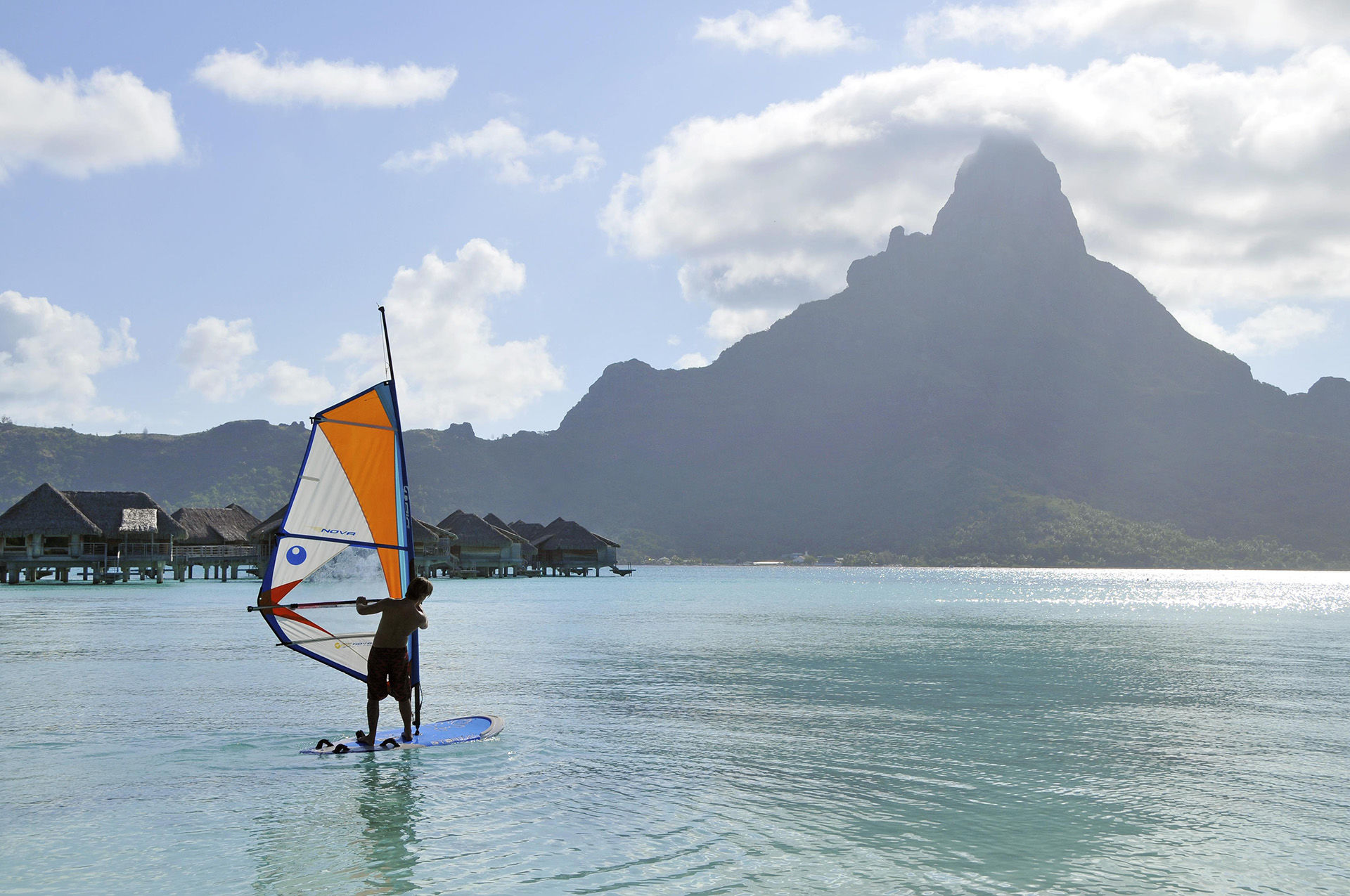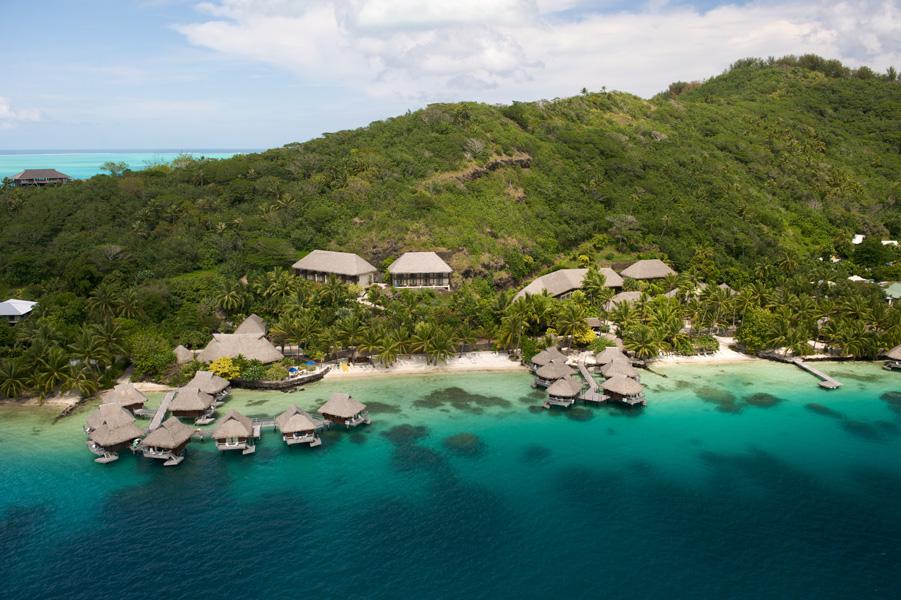
Relaxing Glides and Thrilling Rides
It's like walking on water. You stand atop a stable, streamlined board that glides silently across the lagoon, with each paddle stroke revealing new wonders in the clear waters below. Coral heads decked in bright colors pass underneath, tropical fish follow in your wake, and a shadow moving across the white sand bottom transforms into a stingray on patrol. Or, if you'd rather dance that walk, trade the long board for a sail and an agile shortboard that harnesses the power of the wind as you skims and skips across the bright chop. The islands of Tahiti offer rewards for both paddlers and kiters.
Highlights
- Best for: All travellers, watersports and spa enthusiasts and adventures ranging from soft to rugged
- Best season to visit: Year round
- Weather: North America's summer and early fall are the coolest and driest months in Tahiti, with temperatures ranging from 70 to 82 degrees. November to March is a bit warmer, with more chance of rain, but there is no bad time for a visit
Tahiti Information
Board Sports in Tahiti Overview
The fringing reefs that surround mountainous islands such as Bora Bora and Moorea create sheltered lagoons that offer both protected areas for paddlers and flat-water sites for kiteboarders. Similar opportunities await in low-lying coral atolls such as Rangiroa, Fakarava. A number of resorts provide or rent SUPs, and kiteboarding rentals and lessons are also available.
Board Sports in Tahiti Tips
Kiteboarding is a thrilling sport, but not one that is easy to pick up on your own. Fortunately, most first-time riders take to it quickly when provided with the right instruction and equipment. Equally important is the setting, and Bora Bora's lagoon is an ideal place to practice and perfect your technique.
Best Places for Board Sports in Tahiti
In Moorea, SUP riders launch at the village of Papetoai to paddle to a site where carved stone tikis can be seen submerged in clear shallow water. When trade winds blow, kiteboarders take flight in the waters of Bora Bora's lagoon. The atolls of Rangiroa and Fakarava are ringed in small islands that are ideal for exploration by paddleboard.
What to Pack for Board Sports in Tahiti
Both kiters and paddlers should pack board shorts, a rash guard style water shirt and water shoes with grippy soles. SUP riders should add a flotation device and whistle for safety, a sun hat and sunglasses. Backpack-style hydration bladders are a good idea for longer trips and a waterproof fanny pack for snacks. Use an ankle leash for trips in open water.
Resorts

The Islands of Tahiti
Maitai Polynesia Resort Bora Bora
See Packages & Learn More
Passport and/or Visa Requirements
A valid U.S. passport is required for entry into Tahiti which must be valid for 3 months beyond your date of entry. Your passport needs to have at least 1 blank page for the Tahiti entry stamp. Proof of return or onward ticket is required. No visas are required for tourist stays of less than 90 days.
Immunizations
No immunizations are required for entry into Tahiti, but we would always suggest that you check with your doctor and the Centers for Disease Control on recommended vaccinations for travel to Tahiti at Traveler's Health CDC.
Culture and Customs
Tahiti and the Society Islands loom large in our collective images of tropical paradise. These are the islands that seduced the crew of the Bounty to mutiny, inspired the works of Gauguin and Melville, and now entice celebrities, newlyweds and dreamers to escape the every day for a thatch-roofed bungalow perched over an electric-blue lagoon. As a semi-autonomous territory of France, the islands combine Continental flair with the ancient traditions of Polynesia. Evidence of this blending begins at breakfast, where a bowl of cafe au lait and a buttery croissant are accompanied by fresh papaya, mango and breadfruit, served with a spray of tropical flowers. Tattoo is a Tahitian word, and body art is considered a sign of beauty. Dance has always played an important role in island life, with performances for everything from welcoming visitors to challenging an enemy or seducing a mate. Traditions are kept alive at the annual gathering of Heiva i Tahiti, when islanders from across the archipelago gather at Papeete for celebrations that include elaborate spectacles of song and dance, along with arts and crafts fairs and traditional sporting events such as canoe races and strong man contests. A year-round staple of Tahitian culture are flowers, which grow in abundance across the islands. Bright blossoms are worn in floral crowns or as single displays behind the ears, denoting either one's availability or commitment. The same long-standing traditions of hospitality that welcomed early European explorers and subsequent generations of sailors are now lavished on arriving vacationers, who will discover not only some of the friendliest people in the world, but also some of the most seductive landscapes, where sea, sky and island come together in riotous shades of blue and green.
Electricity, Phone and Internet Access
Electricity in Tahiti is 220 Volts, 60 cycles. Hotels may use 110 or 220 Volts depending on your location, so a converter/adapter is often required for appliances you bring, including computers.
Direct dialing international calling is available in most hotels. When calling from the U.S. to Tahiti, dial 011 and then the country code of 689 along with the local number. Check with your cell phone provider to see if they have an international plan that is compatible in Tahiti for voice, text and data.
Internet access is available in many hotels and resorts.
Water Quality
Tap water is safe to drink in Papeete and Bora Bora. Elsewhere bottled water is recommended and readily available.
Language & Currency
French and Tahitian are the official languages, but English is spoken and understood in tourist areas.
The currency of Tahiti is the French Pacific Franc (XPF). Bank notes come in denominations of 500, 1000, 5000 and 10,000, and coins in denominations of 1, 2, 5, 10, 20, 50 and 100.
Credit cards are readily accepted in most tourist destinations. Most guests exchange money at the airport upon arrival or at their hotel, but the best exchange rate should be at a local bank.
Time
There are three time zones in Tahiti. The Society Islands including Papeete and Moorea and the Leeward Islands including Bora Bora, and the Tuamotu Islands including Fakarava and Rangiroa are all 10 hours behind Greenwich Mean Time (-10 GMT). The Gambier Islands are 9 hours behind Greenwich Mean Time (-9 GMT). The Marquesas Islands are 9.5 hours behind Greenwich Mean Time (-9.5 GMT). Tahiti does not use daylight savings time.
Location, Size and Population
Tahiti is located south of the equator halfway between California and Australia. The islands of Tahiti, known as French Polynesia, consist of 5 island groups. There are 118 islands with a total land mass of 1,544 square miles.
The population of French Polynesia is 285,699 (2016).